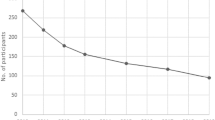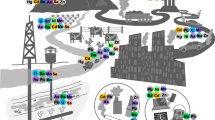Abstract
The Jinchang Cohort was an ongoing 20-year ambispective cohort with unique metal exposures to an occupational population. From January 2014 to December 2019, the Jinchang Cohort has completed three phases of follow-up. The baseline cohort was completed from June 2011 to December 2013, and a total of 48 001 people were included. Three phases of follow-ups included 46 713, 41 888, and 40 530 participants, respectively. The death data were collected from 2001 to 2020. The epidemiological, physical examination, physiological, and biochemical data of the cohort were collected at baseline and during follow-up. Biological specimens were collected on the baseline to establish a biological specimen bank. The concentrations of metals in urine and serum were detected by inductively coupled plasma mass spectrometry (ICP-MS). The new areas of research aim to study the all-cases mortality, the burden of diseases, heavy metals and diseases, and the course of the chain from disease to high-risk outcomes using a combination of macro and micro means, which provided a scientific basis to explore the pathogenesis of multi-etiology and multi-disease and to evaluate the effects of the intervention measures in the population.
Similar content being viewed by others
Availability of data and material
The Jinchang Cohort welcomes proposals for collaborative projects to foster collaboration and maximize the use of existing data. For more information, please contact professor Yana Bai [baiyana@lzu.edu.cn], or professor Ning Cheng [chengn@lzu.edu.cn].
References
GoD C. Global, regional, and national age-sex specific mortality for 264 causes of death, 1980–2016: a systematic analysis for the Global Burden of Disease Study 2016. Lancet (London, England). 2017;390(10100):1151–210. doi:https://doi.org/10.1016/s0140-6736(17)32152-9 .
Melberg A, Teklemariam L, Moland KM, Aasen HS, Sisay MM. Juridification of maternal deaths in Ethiopia: a study of the Maternal and Perinatal Death Surveillance and Response (MPDSR) system. Health Policy Plann. 2020;35(8):900–5. doi:https://doi.org/10.1093/heapol/czaa043.
Zhou M, Wang H, Zeng X, et al. Mortality, morbidity, and risk factors in China and its provinces, 1990–2017: a systematic analysis for the Global Burden of Disease Study 2017. Lancet (London England). 2019;394(10204):1145–58. doi:https://doi.org/10.1016/s0140-6736(19)30427-1.
Zhou M, Wang H, Zhu J, et al. Cause-specific mortality for 240 causes in China during 1990–2013: a systematic subnational analysis for the Global Burden of Disease Study 2013. Lancet (London England). 2016;387(10015):251–72. doi:https://doi.org/10.1016/s0140-6736(15)00551-6.
WHO. The top 10 causes of death.<https://www.who.int/news-room/fact-sheets/detail/the-top-10-causes-of-death>(retrieved 20.01.21). 2020.
IDF. (International Diabetes Federation) IDF Diabetes Atlas (Ninth Edition). 2019. 2019. doi:https://www.idf.org/sites/default/files/EN_6E_Atlas_Full_0.pdf.
Hectors TL, Vanparys C, van der Ven K, et al. Environmental pollutants and type 2 diabetes: a review of mechanisms that can disrupt beta cell function. Diabetologia. 2011;54(6):1273–90. doi:https://doi.org/10.1007/s00125-011-2109-5.
González-Villalva A, Colín-Barenque L, Bizarro-Nevares P, et al. Pollution by metals: Is there a relationship in glycemic control? Environ Toxicol Pharmacol. 2016;46:337–43. doi:https://doi.org/10.1016/j.etap.2016.06.023.
Liu B, Feng W, Wang J, et al. Association of urinary metals levels with type 2 diabetes risk in coke oven workers. Environ pollution (Barking Essex: 1987). 2016;210:1–8. doi:https://doi.org/10.1016/j.envpol.2015.11.046.
Yang A, Liu S, Cheng N, et al. Multiple metals exposure, elevated blood glucose and dysglycemia among Chinese occupational workers. J Diabetes Complicat. 2017;31(1):101–7. doi:https://doi.org/10.1016/j.jdiacomp.2016.07.022.
Wang X, Mukherjee B, Karvonen-Gutierrez CA, et al. Urinary metal mixtures and longitudinal changes in glucose homeostasis: The Study of Women’s Health Across the Nation (SWAN). Environ Int. 2020;145:106109. doi:https://doi.org/10.1016/j.envint.2020.106109 .
Cao B, Fang C, Peng X, et al. U-shaped association between plasma cobalt levels and type 2 diabetes. Chemosphere. 2020;267:129224. doi:https://doi.org/10.1016/j.chemosphere.2020.129224 .
Bai Y, Yang A, Pu H, et al. Cohort Profile: The China Metal-Exposed Workers Cohort Study (Jinchang Cohort). Int J Epidemiol. 2017;46(4):1095-6e. doi:https://doi.org/10.1093/ije/dyw223 .
Chen W, Zheng R, Zuo T, Zeng H, Zhang S, He J. National cancer incidence and mortality in China, 2012. Chinese journal of cancer research = Chung-kuo yen cheng yen chiu. 2016;28(1):1–11. doi:https://doi.org/10.3978/j.issn.1000-9604.2016.02.08 .
Chen W, Zheng R, Zhang S, Zhao P, Zeng H, Zou X. Report of cancer incidence and mortality in China, 2010. Annals of translational medicine. 2014;2(7):61. doi:https://doi.org/10.3978/j.issn.2305-5839.2014.04.05 .
Chen W, Zheng R, Zhang S, et al. Report of incidence and mortality in China cancer registries, 2009. Chinese journal of cancer research = Chung-kuo yen cheng yen chiu. 2013;25(1):10–21. doi:https://doi.org/10.3978/j.issn.1000-9604.2012.12.04 .
Yang AM, Cheng ZY, Pu HQ, et al. Heavy Metal Assessment among Chinese Nonferrous Metal-exposed Workers from the Jinchang Cohort Study. Biomed Environ Sci: BES. 2017;30(7):530–4. doi:https://doi.org/10.3967/bes2017.070 .
Yang AM, Cheng N, Pu HQ, et al. Metal Exposure and Risk of Diabetes and Prediabetes among Chinese Occupational Workers. Biomed Environ Sci: BES. 2015;28(12):875–83. doi:https://doi.org/10.3967/bes2015.121 .
Yang A, Liu S, Cheng Z, et al. Dose-response analysis of environmental exposure to multiple metals and their joint effects with fasting plasma glucose among occupational workers. Chemosphere. 2017;186:314–21. doi:https://doi.org/10.1016/j.chemosphere.2017.08.002 .
Yang A, Cheng N, Pu H, et al. Occupational metal exposures, smoking and risk of diabetes and prediabetes. Occupational medicine (Oxford. England). 2017;67(3):217–23. doi:https://doi.org/10.1093/occmed/kqw078 .
Yang AM, Hu XB, Liu S, et al. Occupational exposure to heavy metals, alcohol intake, and risk of type 2 diabetes and prediabetes among Chinese male workers. Chronic Dis Transl Med. 2019;5(2):97–104. doi:https://doi.org/10.1016/j.cdtm.2019.05.002 .
Yang A, Liu S, Cheng N, et al. Reproductive factors and risk of type 2 diabetes in an occupational cohort of Chinese women. J Diabetes Complicat. 2016;30(7):1217–22. doi:https://doi.org/10.1016/j.jdiacomp.2016.06.011 .
Wang M, Jin Y, Dai T, et al. Association between ambient particulate matter (PM(10)) and incidence of diabetes in northwest of China: A prospective cohort study. Ecotoxicol Environ Saf. 2020;202:110880. doi:https://doi.org/10.1016/j.ecoenv.2020.110880 .
Cheng Z, Cheng N, Shi D, et al. The Relationship between Nkx2.1 and DNA Oxidative Damage Repair in Nickel Smelting Workers: Jinchang Cohort Study. Int J Environ Res Public Health. 2019;16(1). doi:https://doi.org/10.3390/ijerph16010120 .
Acknowledgements
We thank all study participants and staff of the Worker’s Hospital of the JNMC for their generous work, and the interviewers from the Department of Epidemiology and Health Statistics, School of Public Health, Lanzhou University. We also thank Prof. Tongzhang Zheng and Prof. Simin Liu from Brown University, Prof. Jie He, Prof. Min Dai, and Prof. Yawei Zhang from the Chinese Academy of Medical Sciences for their support and help. As a visiting fellow of Queensland University of Technology, Jingli Yang would thank the support from the China Scholarship Council (CSC).
Funding
This work was supported by the National Natural Science Foundation of China [grant number 81673248] and Construction of the Whole Process Management System for Metabolic Diseases among Staff in Jinchuan Group Co Ltd (jinkezong 2020-02).
Author information
Authors and Affiliations
Contributions
Yana Bai, Ning Cheng, designed and oversaw the project. Desheng Zhang, Chun Yin, Yufeng Wang, Na Li, Feng Kang, Xijiang Wu, and Jiao Ding provided coordination for data collection of physical examination, clinical diagnosis and Biochemical tests at different stages of the project implementation. Juansheng Li, Xiaobin Hu, Shan Zheng, Minzhen Wang, Xiaowei Ren, Ruonan Wang, Rui Zhang, Zhao Bai, Lulu Xu, Yarong Chen, Jing Li, Siyu Li, Yujia Hu, Wenling Zhang, Yanyan liu contributed to the fieldwork implementation and were in charge of data quality control and preliminary checks of the data and its documentation. Jingli Yang, Zhiyuan Cheng, Ruonan Wang, Rui Zhang, and Zhao Bai designed the analytical strategy. Yana Bai and Jingli Yang prepared the first draft of the manuscript, and all authors reviewed and refined the paper.
Corresponding author
Ethics declarations
Conflicts of interest/Competing interests
None declared.
Ethics approval
The study was approved by Lanzhou University School of Public Health [IRB00011828] and the U.S. Department of Health and Human Services [FWA00027712].
Additional information
Publisher’s note
Springer Nature remains neutral with regard to jurisdictional claims in published maps and institutional affiliations.
Jingli Yang as the co-first author has contributed to this article equally.
Electronic supplementary material
Below is the link to the electronic supplementary material.
Rights and permissions
About this article
Cite this article
Bai, Y., Yang, J., Cheng, Z. et al. Cohort Profile Update: the China Metal-Exposed workers Cohort Study (Jinchang Cohort). Eur J Epidemiol 37, 641–649 (2022). https://doi.org/10.1007/s10654-022-00875-4
Received:
Accepted:
Published:
Issue Date:
DOI: https://doi.org/10.1007/s10654-022-00875-4




